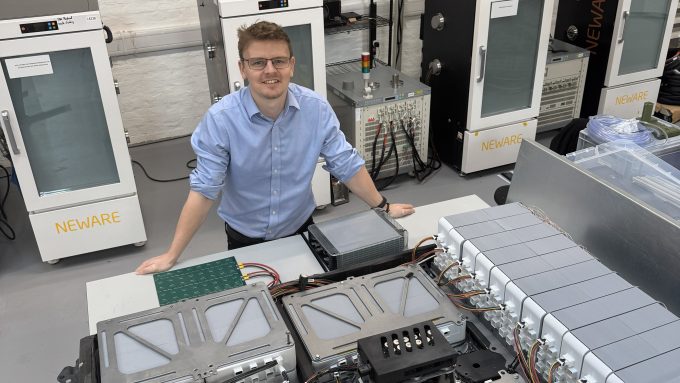
Meet the Innovator embracing AI to track biodiversity on rooftops

“Climate change is making UK cities hotter, and green roofs are a great way of cooling buildings down,” explains ecologist and bird watcher Dusty Gedge, who travels the world promoting the benefits of increasing biodiversity in urban areas by introducing greenery to rooftops.
Over the last 25 years, he has gone from promoting rudimental ‘brown’ roofs using crushed concrete and brick on buildings beside Deptford Creek, to ‘green’ roofs atop some of central London’s most luxurious office developments; featuring wildflowers and grasses.
More recently the charismatic “geezer from Lewisham” who is described by others as the “green roof guru” co-founded technology company Gentian which uses artificial intelligence to map the spread of green roofs in cities, determine their suitability and identify flat roofs with the most potential for greening.
Last autumn Dusty was a guest at a panel discussion convened by Connected Places Catapult at UK Construction Week, where he spoke about the benefits of green roofs and opportunities for installing them on buildings as part of retrofit programmes.
“Back in 2010 there were about 200,000 square metres of green roof in London. Ten years later this had grown to 1.5 million square metres; around 0.19 square metres per citizen. We have achieved a great deal in a short space of time, but London is a long way behind Basel in Switzerland whose figure is 5.1 square metres per person.”Dusty Gedge, co-founder of Gentian
As a rule of thumb he says a good green roof features around 80 - 150mm of substrate, and a mix of wildflowers and sedum plants.
Speeding up surveys using AI
Eight years ago Dusty decided to record green roof coverage in the capital, to track progress. He “spent the whole of August on Google Maps, marking every single one of them”. But a chance conversation with a friend led to a revelation.
“I was chatting to Daniel White (his now business partner) who had started a technology company. He asked why not use AI to monitor the green roof coverage to save time; so we formed Gentian.”
Soon they were joined by former Airbus engineer Thomas Fenal, and the company won a contract with the European Space Agency to look at mapping green roofs. Last year, more funding was received from the Agency to further develop the work.
Gentian is currently working to better understand how AI can interrogate images to differentiate between different types of green roofs and their habitats.
This level of understanding is important, Dusty says, because there is a huge variety in the quality of green roofs, and developers in England will soon have to meet ‘biodiversity net gain’ targets. “There are basic, off-the-shelf green roof blankets you can install which look nice, but they are not very good from a biodiversity perspective. The best green roofs need a mix of wildflowers, seeds and an element of topography to create a habitat.”

There is further need for improved biodiversity associated with buildings because of new recommendations known as TNFDs – or Taskforce on Nature-related Financial Disclosures – which encourage organisations to embrace nature. “Clients want to know if the green roofs they are getting are actually what they need,” explains Dusty.
“I’ve been talking to several legal firms, banks and accountancy practices and they tell me that because of TNFDs, the most important aspect of their buildings are their green roofs.
“I expect green roofs will become a larger part of the policy agenda in England,” he adds. “Over the years I have advised authorities in Edinburgh, Belfast and South Wales, and have recently published a league table of green roofs in cities of the UK.”
Early years
Dusty Gedge was fascinated by nature at an early age. “My mother told me I fell over and cracked my head chasing a robin at the age of two, and was never the same since.” He grew up in east Kent “surrounded by shingle and salt marshes”, studied theatre arts at college, worked as an actor and formed a street entertainment group in Devon. He got a job as a circus performer at a theatre in Deptford, southeast London and moved to nearby Blackheath where he has lived ever since.
While performing at the circus, he chatted to officials from Greenwich Council who were looking for a professional birdwatcher and ecologist to help with their sustainability efforts. Dusty later identified a rare breed of bird and suggested developers create a suitable habitat on a roof. “And that’s how my work with roofs started,” he says.
In the late 1990s he worked with the London Biodiversity Partnership to create a brown roof at a site in Deptford Creek.
“Back then we didn’t know much; but were working in these post-industrial landscapes covered in brick and concrete, hence the term ‘brown’. The idea was to place crushed material on a rooftop, but concrete doesn’t retain water – which is what you need for a successful green roof.”Dusty Gedge, co-founder of Gentian
Dusty later volunteered with the London Wildlife Trust where a colleague told him about a biodiversity specialist from Switzerland researching green roofs. So in May 2000, Dusty flew out to meet him. Brimming with ideas, Dusty set up a PhD study in green roofs in London.
Three years later he met with several green roof companies who sponsored the setting up of Living Roofs, which campaigned for a green roof policy in the capital which caught the attention of the Greater London Authority.
Dusty later co-authored a technical report to support the new London Plan policy in 2008, and was elected President of the European Federation of Green Roof and Wall Associations. He also designed a large green roof for the former broadcast centre at the Olympic Park in Stratford. Today he spends his early mornings walking around Blackheath and Greenwich recording nature, between conference visits around the globe.
Opportunities for retrofit
Looking ahead, Dusty says a third of the central London skyline could be retrofitted with green roofs. “There is a real opportunity here to deliver nature and climate resilience, but the problem is a lot of designers want beautification, not nature. This is not about creating a garden; we must focus on function over form.”
An indication that green roofs attract wildlife can be seen at the Greenwich Peninsula, he says, where 90% of new developments have one, and a bird called the Linnet has increased in population over the last 20 years.

Dusty is currently talking to Connected Places Catapult about ways to support companies looking to retrofit their buildings to accommodate green roofs. “Being able to engage with the Catapult on something which is fairly innovative, getting a positive response and hearing their enthusiasm for this initiative has been great,” he says.
While pitched roofs on houses offer limited scope for greening, Dusty says residential extensions with flat roofs (and even garden sheds) present options.
A measure of success for green roofs would be if many more buildings – new and old – installed them, Dusty says. The future looks bright, he adds. “Most young people are very aware of climate change, and there are great career opportunities for those who want to be involved in this industry and make a difference to the world.”
His favourite green roof belongs to a legal firm in the shadow of St Paul’s Cathedral. “Every time I go up there and sit down,” he says, “I feel joy.”





